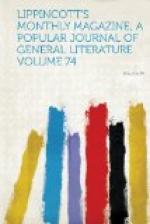Mr. Heraud also accepts the order of the Sonnets as correct. His book contains an article on the Sonnets published by him in Temple Bar for April, 1862, the result, he declares (and far be it from us to dispute it), of pure induction. He has evolved the theory that Shakespeare in writing against celibacy had in view the practice of the Roman Catholic Church; that the friend whom he apostrophizes was the Ideal Man, the universal humanity, who gradually develops into the Divine Ideal, and becomes a Messiah, while the Woman is the Church, the “black but comely bride” of Solomon. “Shakespeare found himself between two loves—the celibate Church on the one hand, that deified herself, and the Reformed Church on the other, that eschewed Mariolatry and restored worship to its proper object.... Thus, Shakespeare parabolically opposed the Mariolatry of his time to the purer devotion of the word of God, which it was the mission of his age to inaugurate.”
This is pretty well for a flight of inductive genius, but it is quite surpassed by the soaring Teutonic mind before mentioned, who, in the words of the reflective Breitmann,
Dinks so deeply
As only Deutschers can.
This mighty philosopher, of whom Mr. Heraud speaks with becoming reverence, is Herr Barnstorff, who published a book in 1862 to prove that the “W.H.” of the dedication means William Himself, and that the Sonnets are apostrophes to Shakespeare’s Interior Individuality! Mr. Heraud thinks this idea is rather too German, but, after all, not so very far out of the way, for in Sonnet 42 the poet certainly declares that his Ideal Man is simply his Objective Self.[009] For, as Mr. Heraud beautifully and lucidly remarks, “the Many, how multitudinous soever, are yet properly but the reflex of the One, and the sum of both is the Universe.” And herein, according to Mr. Heraud, we find the key to the mystery.
In 1866, Mr. Gerald Massey published a large volume on the same subject, with the somewhat pretentious title. Shakespeare’s Sonnets, never before interpreted; his private friends identified; together with a recovered likeness of himself. The first chapter contains a summary of the opinions of Coleridge, Wordsworth and others upon the Sonnets; a notice of the theory of Bright and Boaden (Gentleman’s Magazine, 1832), afterward confirmed by a book written by Charles Armitage Brown (1838); the theories of Hunter, Hallam, Dyce, Mrs. Jameson, M. Chasles, Ulrici, Gervinus and many others (most of them, by the way, confirming the theory originated by Boaden and Bright); and having thus gone over the work of twenty-five named authors, and a space of time extending from 1817 to 1866, Mr. Massey begins his second chapter by saying that as yet there has never been any genuine attempt to interpret the Sonnets, “nothing having been done except a little surface-work.” Mr. C. Armitage Brown in particular (who, by the way,




